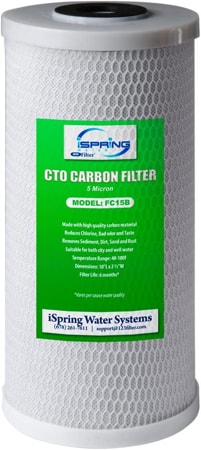A detailed study by the State University of New York at Fredonia found that 83% of tap water worldwide contains microplastics. The U.S. has the highest presence, with 94% of U.S. tap water contaminated with microplastics. Microplastics are also found in bottled water. They are found in 93% of 11 popular water bottle brands worldwide. When a contaminant is excessively found in water, you must choose productive techniques for its removal.
Water filters have successfully reduced and eliminated microplastics from drinking water. A study suggests that microplastics can be as large as 2.5 microns. Therefore, the best way to remove them is to use filter media of 2.5 microns or smaller. Finer cartridges or membranes remove more plastic. This guide provides detailed information regarding microplastics in drinking water.
What are Microplastics?
Microplastics are tiny plastic particles that result from both commercial product development and the breakdown of larger plastics. As pollutants, microplastics can harm the environment and animal health. They are defined as plastic less than 5 mm in diameter. This is smaller in diameter than standard beads used in jewelry.
There are two categories of microplastics: primary and secondary. Primary microplastics are small particles in commercial applications such as cosmetics and microfibers including fabrics such as clothing and fishing nets. Secondary microplastics are particles that form when large plastic items such as water bottles break down. This degradation is mainly caused by environmental factors such as solar radiation and ocean waves.
Health Concerns of Microplastics in Drinking Water
As per available scientific information, the World Health Organization (WHO) has concluded that microplastics in drinking water pose no serious risk to human health if not present excessively. However, they can become very dangerous, especially when present excessively in drinking water.
Microplastics are derived from petrochemicals derived from oil and gas products. Some of these particles are toxic to humans, contain carcinogenic or mutagenic chemicals, and can cause cancer and DNA damage. Researchers hypothesize that human exposure to microplastics can cause oxidative stress, DNA damage, inflammation, and more. Especially when inflammation becomes chronic, it can lead to serious health problems.
How to Test Microplastics in Water?
Before choosing the right filtration techniques for water microplastics, you must conduct tests for them. Checking water quality for microplastic presence and level should be the first step. There could be three possible ways for microplastic testing in water.
- For testing, the best way is to get it done through a certified lab. Water testing through professionals is the best way you can get accurate results.
- Various authentic companies are selling their water testing kits to check microplastics in water. A few of them are “Tap Score” and “SimpleLab.” You can get any authentic water testing kit made for microplastics testing. After buying the kit, you just have to follow the instructions provided by the manufacturer to get your water test done.
- If you want to do your microplastic water test at home, you can use agglomeration and staining technique. Agglomeration is a useful technique as it makes microplastics larger and easier to detect. You might be able to combine it with dyes. Nile Red fluorescent dye can detect and quantify microplastics of various sizes. Nile Red works by attaching itself to plastics and causing the microplastics to fluoresce under blue light. Nile Red adheres best to microplastics and has the highest fluorescence activity. (A device should be developed that takes water samples and uses fluorescent lights and dyes to detect microplastics in the samples).
Note: It’s difficult to perform this test at home; I recommend you go for lab testing.
Methods to Remove Microplastics from Water
There are several ways to filter water to remove microplastics. A few of the most effective ones are:
- Microfiltration and Ultrafiltration
- Reverse osmosis
- Carbon filter
Microfiltration and Ultrafiltration
Microfiltration refers to the passage of impure liquids through semi-permeable membranes with pore sizes between 0.1 and 10 microns (or microns). Since microplastics are larger than this dimension, microfiltration can be used to remove most microplastics. Some water filters are available on Amazon that are useful for removing microplastics. If you suspect your water has higher microplastic concentrations, you can get such filters to enjoy contamination-free water.
Ultrafiltration uses the same principles as microfiltration but with smaller pores (0.1 to 0.01 microns) and is a more effective and comprehensive method of reducing microplastics in water.
Reverse Osmosis Filtration
Reverse osmosis (RO) is the best method for removing microplastics from water because it uses a special removal mechanism. In reverse osmosis, contaminated water passes through a semi-permeable membrane with a pore size of 0.0001 microns against its natural concentration gradient.
By moving the contaminated water from an area of high contaminant concentration to an area of low, the microplastics stay on one side, and the pure water is pushed to the other. RO filters also desalinate and soften water.
Carbon Filters
Activated carbon filters help reduce the concentration of microplastics in water by trapping them in small pore spaces within the activated carbon medium. Two main types of carbon filters are used to filter water; granular activated carbon (GAC) filters and carbon block filters.
Granular activated carbon (GAC)

These are used in drinking water filters and typically have a carbon particle size ranging from 0.8 to 1.0 mm. The problem with GAC filters is that water tends to form channels between carbon particles. This allows for faster filter speeds but at the cost of allowing more contaminants such as microplastics to pass through.
Carbon block filter
Carbon block filters are denser than GAC filters. The carbon particle size of powdered activated carbon filters is generally less than 0.18 mm. It takes longer for the water to pass through carbon block filters, but these filters are smaller than his GAC filters and can remove more microplastics from the water.
Both types of carbon filters remove microplastic size fractions to some extent but are not as effective as microfiltration, ultra-filtration, or reverse osmosis.

Leave a Reply